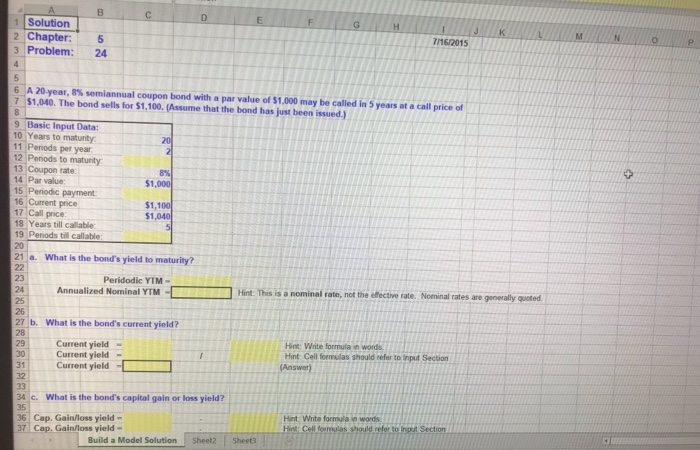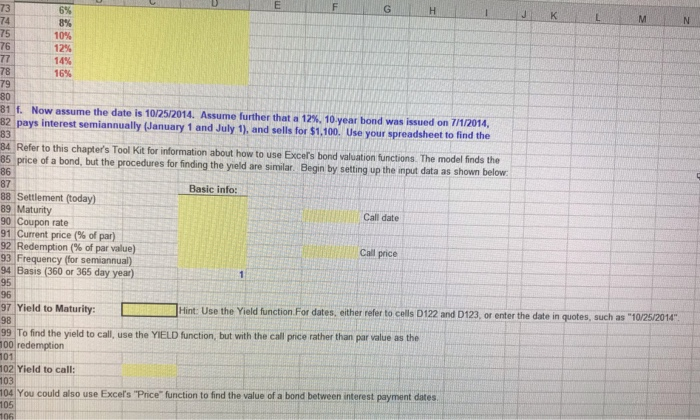B G H Solution 2 Chapter: 3 Problem: MNOP 7/16/2015 24 6 A 20 year, 8% semiannual coupon bond with a par value of $1,000 may be called in 5 years at a call price of 7 $1,040. The bond sells for $1,100. (Assume that the bond has just been issued.) 9 Basic Input Data: 10 Years to maturity 11 Perods per year 12 Periods to maturity 13 Coupon rate: 14 Par value 15 Periodic payment 16 Current price 17 Call price 18 Years till callable 19 Periods till callable $1,000 $1,100 $1.040 21 a. What is the bond's yield to maturity? SON Peridodic YTM Annualized Nominal YTM Hint This is a nominal rate, not the effective rate. Nominal rates are generally quoted 27 b. What is the bond's current yield? Current yield- Current yield Current yield- Hint: Write formula in words Hint Cellformules should refer to Input Section (Answer) 34 c. What is the bond's capital gain or loss yield? 36 Cap. Gain/loss yield- 37 Cap. Gain/loss yield- Build a Model Solution Hint Write formula in words Hint: Cell formulas should refer to Input Section Sheet2 Sheet 37 Cap. Gain/loss yield - 38 Cap. Gain/loss yield - J K F G H I Hint: Cell formulas should refer to Input Section (Answer) 39 40 Note that this is an economic loss, not a loss for tax purposes 42 d. What is the bond's yield to call? 43 44 Here we can again use the Rate function, but with data related to the call. Peridodic YTC - Annualized Nominal YTC - This is a nominal rate, not the effective rate. Nominal rates are generally quoted. 49 The YTC is lower than the YTM because if the bond is called, the buyer will lose the difference between the call price 50 and the current price in just 4 years, and that loss will offset much of the interest imcome. Note too that the bond is 51 likely to be called and replaced, hence that the YTC will probably be earned. 52 53 NOW ANSWER THE FOLLOWING NEW QUESTIONS: 55 le. How would the price of the bond be affected by changing the going market interest rate? (Hint: Conduct 56 a sensitivity analysis of price to changes in the going market interest rate for the bond. Assume that the 57 bond will be called if and only if the going rate of interest falls below the coupon rate. That is an 58 oversimplification, but assume it anyway for purposes of this problem.) 59 60 Nominal market rate, r: 61 Value of bond if it's not called: 62 Value of bond if it's called: The bond would not be called unless coupon 63 64 We can use the two valuation formulas to find values under differenti's, in a 2-output data table, and then use an IF 65 statement to determine which value is appropriate Value of Bond If: Not called Called $0.00 $0.00 Actual value, considering call likehood: Rate, r Build a Model Solution Sheet2 Sheet E 73 74 G 6% J K M 8% 75 10% 12% 76 77 14 % 16% 78 79 80 81 f. Now assume the date is 10/25/2014. Assume further that a 12 % , 10 year bond was issued on 7/1/2014, 82 pays interest semiannually (January 1 and July 1), and sells for $1,100. Use your spreadsheet to find the 83 84 Refer to this chapter's Tool Kit for information about how to use Excels bond valuation functions. The model finds the 85 price of a bond, but the procedures for finding the yield are similar. Begin by setting up the input data as shown below 86 87 Basic info: 88 Settlement (today) 89 Maturity 90 Coupon rate 91 Current price (% of par) 92 Redemption (% of par value) 93 Frequency (for semiannual) 94 Basis (360 or 365 day year) 95 Call date Call price 1 96 97 Yield to Maturity: Hint: Use the Yield function For dates, either refer to cells D122 and D123, or enter the date in quotes, such as "10/25/2014" 98 99 To find the yield to call, use the YIELD function, but with the call price rather than par value as the 00 redemption 101 102 Yield to call: 103 104 You could also use Excel's "Price" function to find the value of a bond between interest payment dates. 105 106 6% 74 8% 10% 75 76 12% 77 14% 78 16% 79 80 81 f. Now assume the date is 10/25/2014. Assume further that a 12%, 10-year bond was issued on 7/1/2014, 82 pays interest semiannually (January 1 and July 1), and sells for $1,100. Use your spreadsheet to find the 83 84 Refer to this chapter's Tool Kit for information about how to use Excel's bond valuation functions. The model finds the 85 price of a bond, but the procedures for finding the yield are similar. Begin by setting up the input data as shown below 86 87 88 Settlement (today) 89 Maturity 90 Coupon rate 91 Current price (% of par) 92 Redemption (% of par value)) 93 Frequency (for semiannual) 94 Basis (360 or 365 day year) 95 Basic info: Call date Call price 1 96 97 Yield to Maturity: Hint: Use the Yield function For dates, either refer to cells D122 and D123, or enter the date in quotes, such as 10/25/2014 98 99 To find the yield to call, use the YIELD function, but with the call price rather than par value as the 100 redemption 101 102 Yield to call: 103 104 You could also use Excel's "Price" function to find the value of a bond between interest payment dates 105 106 107










